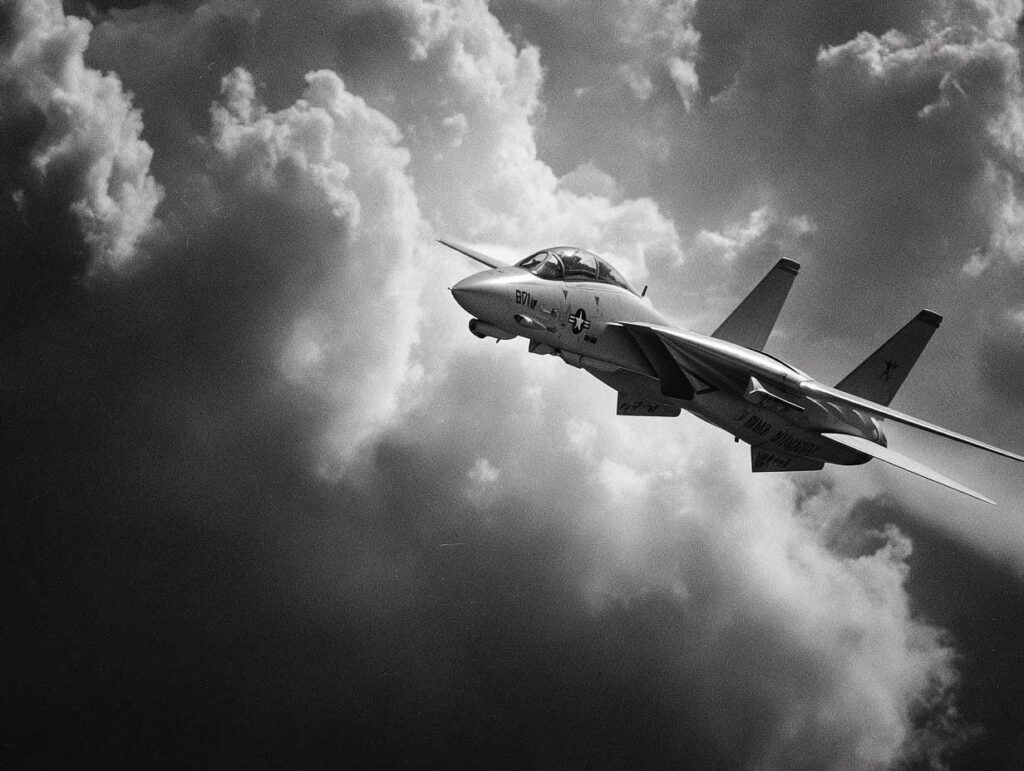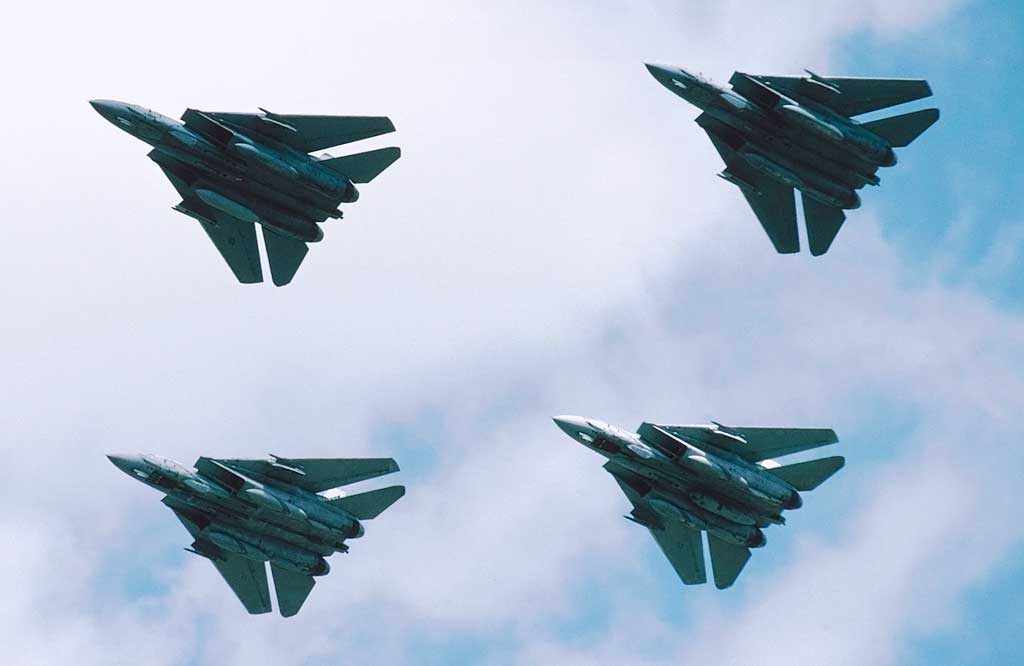
Detailed analysis of the performance of the F-14 Tomcat, a fighter aircraft designed for air superiority and long-range interception missions.
A fighter designed to dominate the skies
The F-14 Tomcat made history in the US Navy as one of the most versatile fighter aircraft of its generation. Entering service with the US Navy in 1974, this twin-engine, two-seat variable-geometry aircraft was designed to meet the specific air defense needs of the fleet. At the time, the growing threat posed by Soviet long-range bombers and their cruise missiles imposed new technological requirements: long range, long-range radar, high-altitude interception capability, and an advanced arsenal.
Beyond its technical performance, the F-14 Tomcat distinguished itself in several conflicts, notably in the Persian Gulf and during the Iran-Iraq War, where aircraft exported to Tehran scored several victories in air combat. Its operational longevity – until 2006 in the US Navy and still in limited use in Iran – is testament to the relevance of its original design.
This article analyzes the main operational capabilities of the F-14 Tomcat in air combat, based on its technical characteristics, electronic equipment, armament, and results in actual missions. The aim is to understand what made the F-14 such a formidable fighter aircraft in its field of action.

A platform designed for air superiority
A stable airframe and variable geometry
The F-14 Tomcat is distinguished by its variable-geometry wings, capable of moving from a 20° extended position for low speeds to a 68° swept-back position for high-speed flight. This configuration optimizes performance depending on the flight phase. During takeoff or landing, the deployed wings provide increased lift and better maneuverability. In air combat, they allow for rapid attitude changes with an appropriate turn speed.
The aircraft is powered by two Pratt & Whitney TF30 engines (later General Electric F110 on the latest versions), providing a total thrust of 108 kN dry and up to 204 kN with afterburner. This allows it to reach Mach 2.34 at high altitude (over 2,500 km/h), with a service ceiling of over 15,000 meters.
Range suitable for area defense
With an internal capacity of more than 9,000 liters of fuel and the ability to carry external tanks, the F-14 could patrol long distances. Its range exceeded 900 km in typical combat missions and more than 1,600 km in pure interception with in-flight refueling. This range was crucial for covering large maritime areas, where aircraft carrier catapults limited frequent rotations.
A revolutionary radar system for its time
The AWG-9: a long-range multi-target radar
The AN/AWG-9 radar, designed by Hughes Aircraft, was one of the key components of the F-14 Tomcat. It could detect an aircraft more than 200 km away in ideal conditions and simultaneously track 24 air targets, with the ability to fire on six of them at a time. This radar was coupled with an onboard computing system that enabled rapid threat analysis and coordination with the weapon systems.
It also offered a look-down/shoot-down capability, allowing it to engage low-altitude targets despite ground radar clutter. This made it an effective weapon against cruise missiles and aircraft flying at nap-of-the-earth altitude.
A complementary IRST system
Some versions of the F-14 were equipped with an IRST (Infrared Search and Track) sensor, useful in environments where radar transmission was risky. Although less accurate than modern devices, this system offered passive threat identification at medium range, particularly in short-range engagements.
Weapons designed for both interception and dogfighting
The Phoenix missile: unique long-range engagement capability
The F-14 Tomcat’s signature weapon was the AIM-54 Phoenix missile, designed to intercept bombers and missile-launching aircraft. With a range of over 190 km, a maximum speed of over Mach 5 and an active seeker, the Phoenix was capable of striking targets before they could even detect the firing aircraft.
Each F-14 could carry up to 6 Phoenix missiles, allowing it to neutralize several aircraft in an enemy group. In a naval engagement against reconnaissance aircraft or long-range bombers, this missile offered unmatched engagement capabilities.
More versatile missiles and an integrated cannon
The Tomcat also carried AIM-7 Sparrow semi-active radar-guided missiles and AIM-9 Sidewinder infrared-guided missiles for medium- and short-range engagements. In close combat, the M61 Vulcan 20 mm cannon, mounted in the fuselage with 675 rounds, provided effective defense, especially at ranges of less than 1,500 meters.
This versatility allowed the F-14 to perform traditional air superiority missions as well as area defense and offensive escort missions.

A feared fighter in actual combat
A career marked by operational successes
The F-14 Tomcat has seen several combat engagements. The best-known example is against Iranian forces. Before the 1979 revolution, Iran had ordered 79 F-14s. During the Iran-Iraq War (1980-1988), Iranian pilots used the Tomcat to intercept MiG-21s, MiG-23s, and Su-22s. According to several Western estimates, the F-14 achieved more than 160 confirmed aerial victories during this conflict.
On the American side, the Tomcat was also deployed during operations in Libya, notably in 1981 (Gulf of Sirte), where two Libyan MiG-23s were shot down without any losses on the US Navy side.
Effectiveness dependent on pilot/radar operator coordination
The F-14 was operated by two crew members: the fighter pilot and the RIO (Radar Intercept Officer). This configuration allowed for the separation of maneuver management and complex systems, particularly during interception or complex air combat. This duo ensured formidable efficiency, especially at long range, but made the aircraft more demanding in terms of training and coordination.
A gradual end to its career despite its qualities
Limitations in the face of modern technology
Despite its strengths, the F-14 Tomcat was gradually replaced by the F/A-18 Super Hornet, a lighter, less expensive to maintain, and multi-role aircraft. The maintenance cost of the F-14 was estimated at over $38,000 per flight hour, due to its complex structure, demanding maintenance, and the scarcity of spare parts.
A legacy still being studied
Even today, the F-14 is still studied in military schools for its unique characteristics. Its ability to combine long-range detection, firepower, and maneuverability makes it a historic benchmark in air combat, especially in long-range defensive missions from aircraft carriers.
War Wings Daily is an independant magazine.